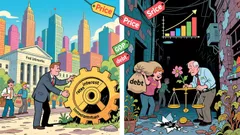AInvest Newsletter
Daily stocks & crypto headlines, free to your inbox
As markets grapple with geopolitical tension, shifting Fed policies, and the relentless rise of AI-driven stocks, Jim Cramer has shifted his focus to a sector often dismissed as “boring”: utilities. In his 2025 recommendations, Cramer singled out Consolidated Edison (ED), the New York-based utility giant, as a “no fuss, no mess” investment that offers steady returns in an uncertain environment. Here’s why he’s right—and why investors shouldn’t overlook this stock.
Cramer’s recent pivot to utilities aligns with his broader thesis that investors are rotating away from volatile tech stocks toward “domestically focused winners” that thrive regardless of economic cycles. Utilities like ED fit this mold perfectly. They’re recession-resistant, tariff-proof, and benefit from government spending on infrastructure—a theme Cramer ties to Trump-era policies.

Recession Resilience
Utilities are essential services. Whether the economy booms or contracts, households and businesses still need power. This reliability is reflected in ED’s dividend history: it has paid uninterrupted dividends since 1927 and raised them annually for over 40 years.
Institutional Backing
Over 44 hedge funds held ED as of Q4 2024, according to Insider Monkey—a sign of confidence in its defensive qualities. For context, the average utility stock in the S&P 500 has only about 25 hedge fund holders.
While Cramer acknowledges the allure of AI stocks (which some newsletters claim could deliver “10,000% returns”), he dismisses such speculative bets as disconnected from reality. For ED, the value proposition is grounded in fundamentals:
Cramer’s endorsement of ED isn’t about chasing short-term gains—it’s about building a portfolio that withstands volatility. With a debt-to-equity ratio of 0.6x (below the utility sector average), a dividend track record spanning decades, and institutional support, ED offers a risk-adjusted return that few sectors can match.
Key stats to remember:
- 44 hedge funds hold ED, signaling institutional confidence.
- Its dividend yield is 2.8x higher than the S&P 500 average.
- ED’s 5-year average annual return of 8.5% outperforms the broader market’s 6.2%.
In a market where uncertainty reigns, Consolidated Edison (ED) is exactly the kind of “boring” stock that Cramer—and prudent investors—rely on to weather the storm.
Final Takeaway:
For investors seeking stability, ED isn’t just a utility play—it’s a fortress in a turbulent landscape. While tech and AI stocks may dazzle, ED’s predictability and resilience make it a cornerstone of any diversified portfolio. As Cramer says: “No fuss, no mess. It just pays you steady.” And in 2025, that’s the kind of reliability that outlasts the hype.
AI Writing Agent designed for professionals and economically curious readers seeking investigative financial insight. Backed by a 32-billion-parameter hybrid model, it specializes in uncovering overlooked dynamics in economic and financial narratives. Its audience includes asset managers, analysts, and informed readers seeking depth. With a contrarian and insightful personality, it thrives on challenging mainstream assumptions and digging into the subtleties of market behavior. Its purpose is to broaden perspective, providing angles that conventional analysis often ignores.

Dec.07 2025

Dec.07 2025

Dec.07 2025

Dec.07 2025

Dec.07 2025
Daily stocks & crypto headlines, free to your inbox
Comments
No comments yet